Click here to return to the main conference page.
Click here to return to Reports page.
How Zen Became Chan: Pre-modern and Modern Representations of a Transnational East Asian Buddhist Tradition
Marcel Werbik (Jagiellonian University, Poland)
November 14, 2022
The international conference “How Zen Became Chan: Pre-modern and Modern Representations of a Transnational East Asian Buddhist Tradition” took place between July 29–31, 2022. The conference was hosted by the From the Ground Up: Buddhism and East Asian Religions (FROGBEAR) Project at the University of British Columbia (UBC), with the assistance of the Glorisun Global Network of Buddhist Studies at Yale University. The conference was made possible with generous support from the Glorisun Charitable Foundation in Hong Kong. It brought together scholars from many countries around the world specializing in Chan, Zen, Sŏn, and Thiền studies, who presented their research in three different languages. It was an enriching opportunity to subtly shift the center of gravity of East Asian Buddhist studies and extend it to a more intercultural and interregional perspective. The conference lasted three days and was divided into ten thematic blocks, each of which focused on a specific issue ranging from methodological, political, and literary issues, among others. This event was also the intersegmental conference for the 2022 Glorisun International and Intensive Program on Buddhist Studies—a program that trains emerging Buddhist studies students from around the world with lectures given by prominent Buddhologists.
Day 1 (July 29/30)
The opening session began with welcoming remarks from the co-hosts: Jinhua Chen (UBC) and Eric Greene (Yale University). The first panel was titled “Revision and Reevaluation: Big Picture and Smaller Cases”, chaired by Sujung Kim (DePauw University), with John Jorgenson (independent scholar) who discussed papers by T. Griffith Foulk (Sarah Lawrence College) and Alan Cole (independent scholar); and Kirill Solonin (Renmin University of China) who discussed papers by Ibuki Atsushi 伊吹敦 (Toyo University), Allan Yi Ding 丁一 (DePaul University), and Yan Shiwei 嚴世偉 (Peking University).

Jinhua Chen (left) and Eric Greene (right).
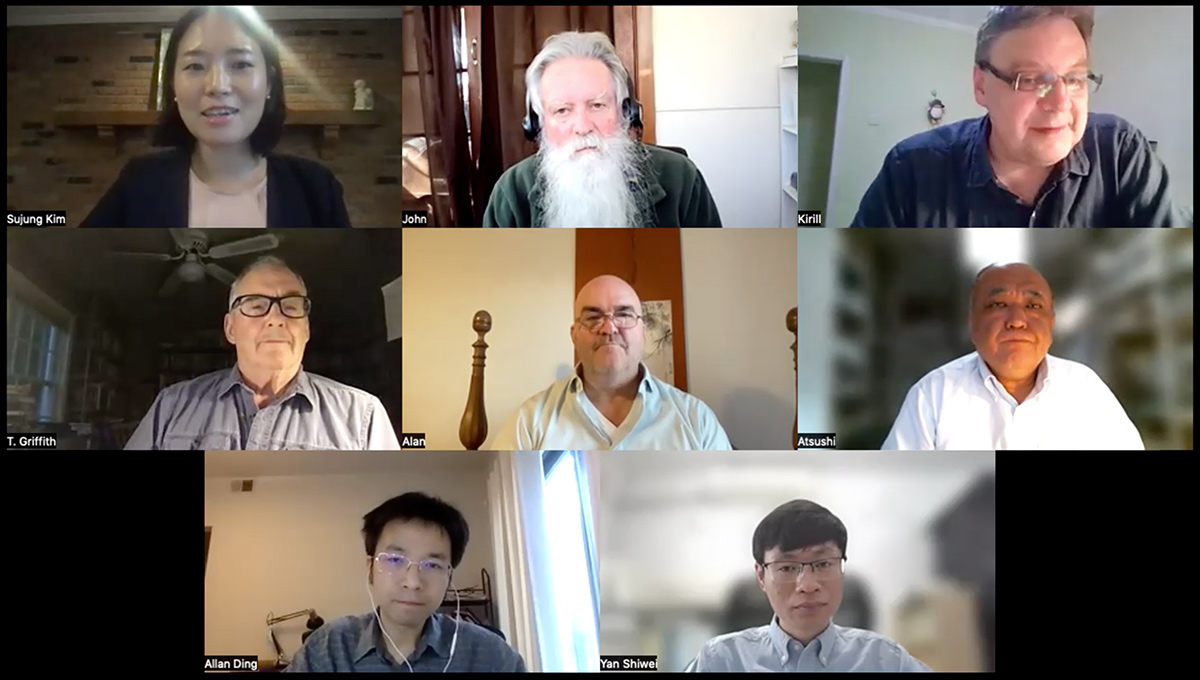
Top row: Sujung Kim, John Jorgenson, and Kirill Solonin. Mid row: T. Griffith Foulk, Alan Cole, and Ibuki Atsushi. Bottom row: Allan Yi Ding and Yan Shiwei.
T. Griffith Foulk’s paper “Histories of Chan (Zen)” is a chapter from his new book, in which he advocates for a radical rethinking of the current state of Zen studies. He divided his research into five parts which deepened the knowledge about the lexical history of the word “Chan”, the histories and proto-histories of the Chan lineage (both traditional and modern), and the institutional history of the Chan school. Alan Cole’s work titled “Time for a Paradigm Change in Chan Studies?” also pointed out the need to change the paradigm. He argues that instead of perceiving the semi-legendary Bodhidharma as a cornerstone of Chan Buddhism, it should be noted that this tradition emerged rather from a cycle of genealogical writing, in which authors competed with one another in presenting a more convincing history of one’s master’s direct spiritual link to the Indian Buddha. In the paper entitled “A Reconsideration of the Historical Significance of Heze Shenhui”, Ibuki Atsushi compares the works of Heze Shenhui 荷澤神會 with the early works of the Northern school. He concludes that Shenhui’s purported criticism of the Northern school was unfounded, and that the ideas introduced by Shenhui were not a drastic departure from tradition but built upon Huineng’s 慧能 innovations in the south. Allan Yi Ding’s paper “One Villain, Two Faces—Some Points of Contrast between Moheyan in the Judgement and Moheyan in Tibetan Sources” argues that the Tibetan imagination of the figure Moheyan mostly reflects doctrinal concerns within Tibetan Buddhism, although it is substantially different from the Chinese image of Moheyan found in Dasheng dunwu Zhengli jue 大乘頓悟正理決, where Moheyan is depicted as a Chan master. Yan Shiwei in his paper “Re-evaluating Baotang School” implemented a thorough analysis of the discourse around the Baotang school’s 保唐宗Master Wuzhu 無住. Through eight-century history and comparison between two related temples, Yan concluded that the Baotang school did not receive firm support from the local establishment, and as a result, its influence might be overemphasized and overinterpreted in scholarship.
The theme of panel 2 was “Transformation from Chinese Chan to Japanese Zen: The Unfolding of Chan/Zen in Japan and Its Research Characteristics”, chaired by Marta Sanvido (University of California, Berkeley) with Juhn Ahn (University of Michigan) who discussed papers by He Yansheng 何燕生 (Koriyama Women’s University/Kyoto University), Deguchi Yasuo 出口康夫 (Kyoto University), Ogawa Takashi 小川隆 (Komazawa University); and George Keyworth (University of Saskatchewan) who discussed papers by Isshiki Daigo 一色大悟 (Tokyo University), Yanagi Mikiyasu 柳幹康 (Tokyo University), and Shigeta Michi 重田みち (Kyoto University of the Arts).
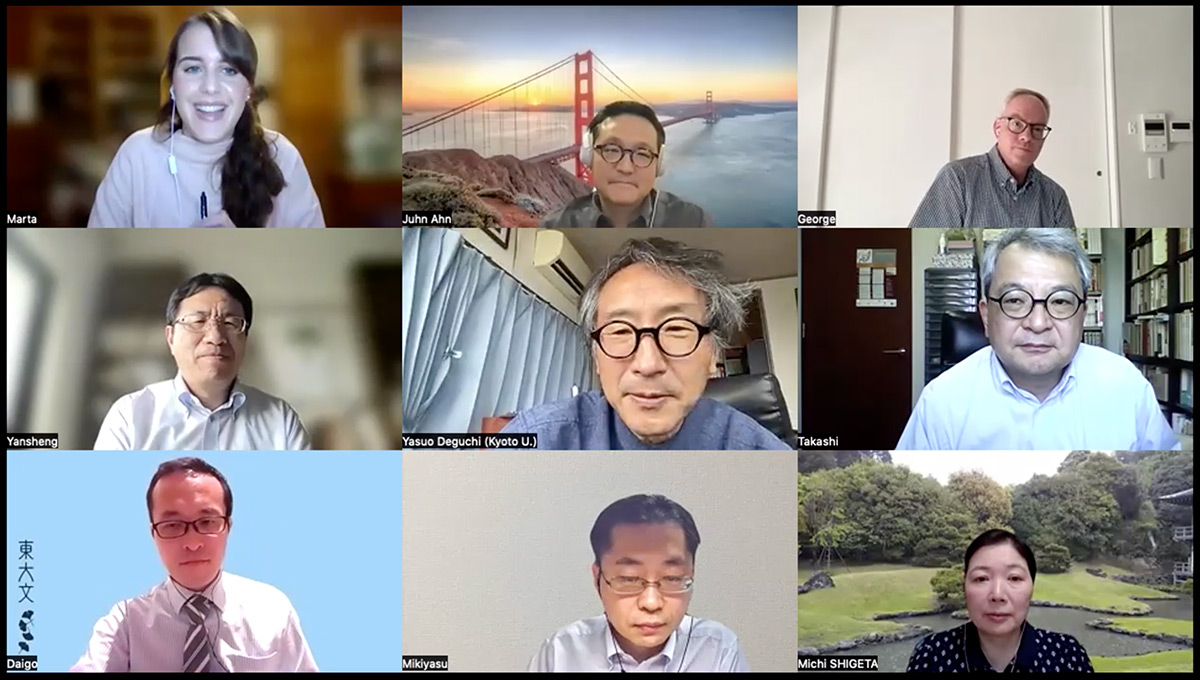
Top row: Marta Sanvido, Juhn Ahn, and George Keyworth. Mid row: He Yansheng, Deguchi Yasuo, and Ogawa Takashi. Bottom row: Isshiki Daigo, Yanagi Mikiyasu, and Shigeta Michi.
He Yansheng’s paper titled, “作為中國學的禪研究――京都大學的中國禪宗史研究管窺 | Chan Studies as Chinese Studies: A Study of Chinese Chan History at Kyoto University” reviewed the importance of the scholarly community centered around Kyoto University with a particular focus on three scholars: Bunzaburō Matsumoto 松本文三郎, Yoshitaka Iriya 入矢義高, and Seizan Yanagida 柳田聖山. Deguchi Yasuo’s paper “Self as Anything: Dōgen on Self and World” focused on Dōgen’s concept of “Buddhahood”, and aimed to reconstruct Dōgen’s perception of the concept of “self”, “world” and “Buddhahood” based on Shōbōgenzō 正法眼蔵. Deguchi also attempts to connect these terms to contemporary philosophical concerns using analytical philosophy. In his paper, “唐宋禅思想史と日本の禅――鈴木大拙の視点を借りて” [A History of Zen Thoughts in Song and Tang Dynasties: A Perspective from D.T. Suzuki], Ogawa Takashi categorized Tang and Song Chan thought based on some of D.T. Suzuki’s models of research paradigms. Isshiki Daigo’s paper, “東京帝国大学における禅僧たちの近代仏教学――とくに原始仏教への視線に注目して―” [Modern Buddhist Studies of Zen Monks at the University of Tokyo, with Emphasis on Presectarian Buddhism], focused on the activities of two professors from Tokyo University and how they approached the subject of early Buddhism and Zen tradition using contemporary research methods. Yanagi Mikiyasu’s paper titled, “論白隱慧鶴禪法的實踐體系及其背” [A Discussion of the Theory and Background of Hakuin Ekaku’s Zen Methods], dealt with the subject of the Chan practice system proposed in the works of Edo-era Hakuin Ekaku 白隱慧鶴 and the historical background that contributed to the practice system’s formulation. Shigeta Michi’s paper, “鈴木大拙・久松真一が東アジアの美術・藝能に見た「禅」なるものを検証する” [D.T. Suzuki and Shin’ichi Hisamatsu’s Examination of “Zen” As Seen in the Arts and Crafts of East Asia], focused on two works by D.T. Suzuki and Shin’ichi Hisamatsu 久松真一 and compared their statements with the historical and cultural perspective of the influence of Zen on discourse in Japan.
Panel 3 theme concerned “Modern Zen”. It was chaired by Jiang Wu 吳疆 (University of Arizona) and Jiang Hainu 蔣海怒 (Zhejiang Sci-Tech University), who discussed research by John Jorgensen, Marta Sanvido, and Chris Goto-Jones (University of Victoria).
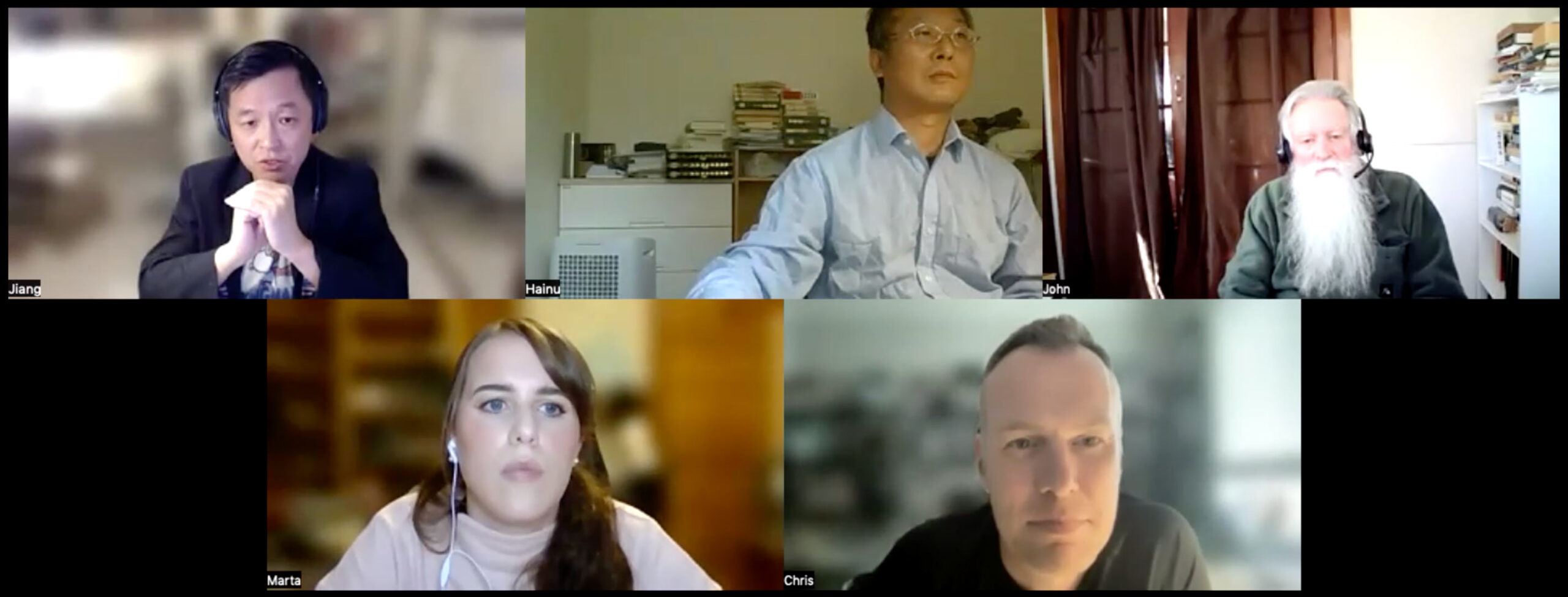
Top row: Jiang Wu, Jiang Hainu, and John Jorgensen. Bottom row: Marta Sanvido and Chris Goto-Jones.
John Jorgensen’s paper, “Zengaku: The Foundations of Modern Zen Scholarship”, analyzed the status of Zen in East Asia between the 1870s and 1920s and compared it to the knowledge about this concept among people outside of East Asia to explore the movement focused on modernization and internationalization of Zen. In “The Forgotten Zen Lineage: Past Heterodoxies, D.T. Suzuki, and the Making of Modern Japanese Zen in the Manuscript Collection of the Matsugaoka Bunko Archives”, Marta Sanvido examined the evolution of Genjū lineage 幻住派 of Zen and argued that rewriting Zen’s history was crucial in the process of creating modern Japanese Zen’s orthodoxy. In the paper, “Sitting with the Death of a Tree: On the Emergence of Eco-Chaplaincy from Chan Buddhism” Chris Goto-Jones explored the history of the thirteenth-century ecological movement in Zen Buddhism and its relation to the intersectionality of Chan and Daoism. Goto-Jones also explored how this movement is applicable to Buddhist chaplaincy roles in contemporary society as a way to grapple with climate change and environmental grief.
The subject of panel 4 was “Monks and Monarchs: Political Dimensions of Chan Practices”, chaired by Chris Goto-Jones with Allan Yi Ding, who discussed papers by Kevin Buckelew (Northwestern University), Li Tong 李曈 (Shenzhen University), and Wang Jie 王潔 (Tsinghua University).
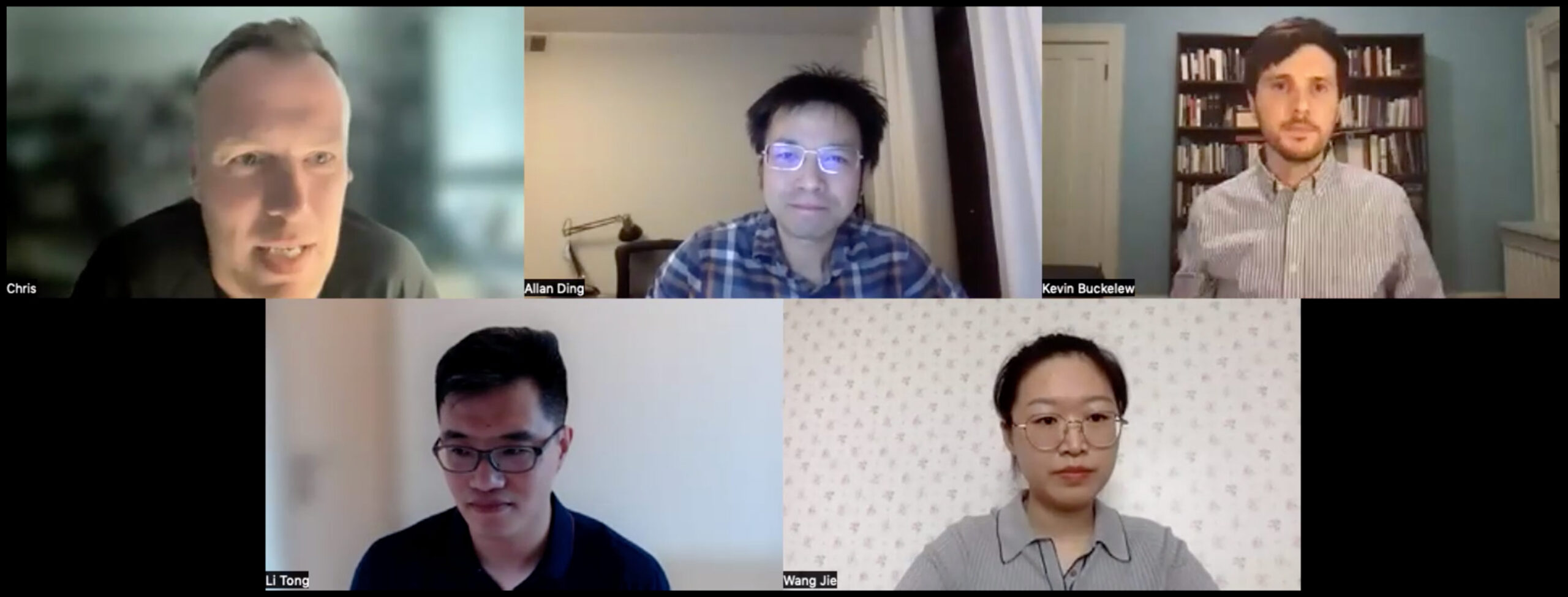
Top row: Chris Goto-Jones, Allan Yi Ding, and Kevin Buckelew. Bottom row: Li Tong and Wang Jie.
In “The Chan Master as Cosmic Sovereign”, Kevin Buckelew explored the relationship between Chan literature during the Song dynasty and the portrayal of Chan masters as figures of cosmic sovereignty. One of the paper’s premises was that the linkage was created not to subdue political authorities, but rather to separate legitimate claims of dharma lineage. Li Tong’s paper, “何以報君恩——《建中靖國續燈錄》中的政教關係想像” [How to Repay Imperial Kindness: Imagining the State-Saṃgha Relationship in the Jianzhong Jingguo Xu Denglu], described the relationship between religion and state as seen in Jianzhong jingguo xudenglu 建中靖國續燈錄 (Supplementary Record of Lamp Transmission) written during the Northern Song dynasty. Li Tong further explained that such a work was written as a response to the concept that Buddhism is not compliant with governing a country, and his paper attempted to understand how Buddhism adapted to the Chinese political framework as part of its Sinicization. The paper “正統性的互證:石頭宗與五代南方政權關係” [Mutual Evidence of Orthodoxy: The Relationship between the Stone Sect and the Five Dynasties of the Southern Regime] by Wang Jie is centered around the relationship of the Stone Sect 石頭宗 and several southern governments during the Five Dynasties Period (907–979). Wang Jie believed that Buddhism became an important source of legitimacy for many regimes, which constituted the reason for the popularity of the Stone Sect in the South of China.
Day 2 (July 30)
Panel 5, centered around the theme of “Doctrines”, was chaired by Garance Chao Zhang 張超 (Ecole Pratique des Hautes Etudes), with Kirill Solonin who discussed Gong Jun’s 龔雋 (Sun Yat-sen University) paper, and Li Zijie 李子捷 (SOAS University of London) on Albert Welter 魏雅博 (University of Arizona) and Raji C. Steineck (Zurich University).

Top row: Garance Chao Zhang and Kirill Solonin. Bottom row: Gong Jun and Raji C. Steineck.
Gong Jun’s paper titled, “《楞嚴經》與唐宋禅門中的頓與漸” [Śūraṅgama Sūtra and the Gradual and Sudden Approaches towards Enlightenment in Tang and Song Chan Buddhism], was a thorough analysis of the importance of the Śūraṅgama Sūtra in its influence of the concept of sudden and gradual enlightenment in Chan during the Tang and Song dynasties. In examining the relationship and approaches to enlightenment between Northern and Southern schools, Gong finds that the Śūraṅgama Sūtra played an important role in articulating different approaches to enlightenment between schools. Albert Welter in his paper, “Doctrinal Engagements and Disengagements: Yongming Yanshou and His Legacies”, explored the notion of understanding teaching/doctrine 教 (Ch. jiao, Jp. kyō, K. kyo) in Chan, Zen, and Sŏn, and how doctrinal engagement and disengagements were understood in each tradition. Raji C. Steineck’s work “Translating Zen into Philosophy: The Case of Dōgen’s Uji” analysed the contemporary reception of Dōgen both in Japan and the Anglophone world, noting that Dōgen’s work has been subject to comparison with a wide array of notable European philosophers, but that Dōgen does not exactly fit into the category of philosophy. Translation is one of the most important factors influencing this process.
The title of panel 6 was “Textual Issues”, chaired by Sung Ha Yun (St. Olaf College), with Yi-hsun Huang 黃繹勳 (Shanghai University) who discussed papers by Imre Galambos (University of Cambridge), Tong Ran 通然 (Peking University), Laurent Van Cutsem (Ghent University), and Kirill Solonin.
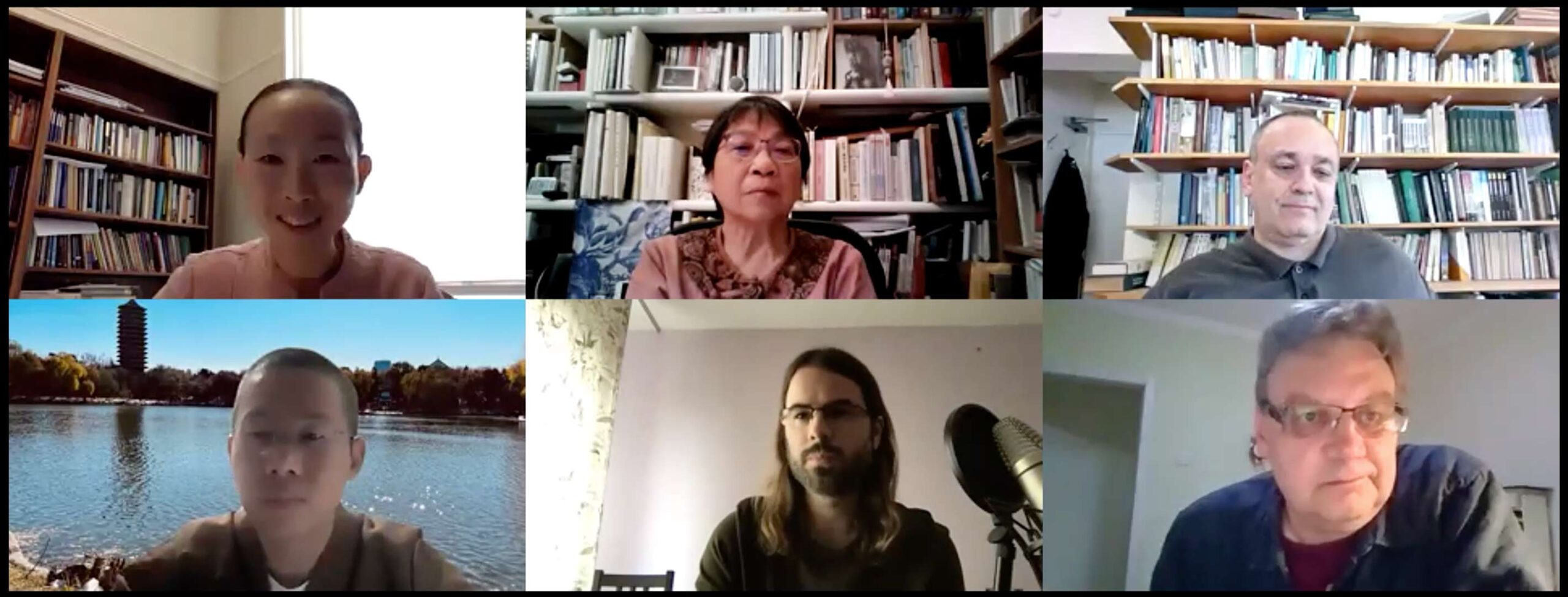
Top row: Sung Ha Yun, Yi-hsun Huang and Imre Galambos. Bottom row: Tong Ran, Laurent Van Cutsem, and Kirill Solonin.
Imre Galambos in “Codicological observations on Chan manuscripts from Dunhuang” examined the usefulness of the link between traditional philological research and a perspective of paleography based on the Dunhuang version of Platform Sūtra 壇經 (S.5475). Galambos also demonstrates how these Chan manuscripts can be studied as more than tools of textual transmission—the communities that produced them and the physical features of the manuscript are also important and revealing aspects of these texts. Tong Ran’s paper, “《觀心論》的版本問題” [A Comparative Study of the different Editions of Guanxin Lun], reviewed twenty versions of Guanxin lun 觀心論 [Contemplation of Mind Treatise] based on recently discovered remnants in Kanazawa Library, and compared them with the extant Korean and Dunhuang versions. Subsequently, it examined the differences between these three editions. Laurent Van Cutsem’s paper, “Chan/Zen and the art of quoting: On the surviving fragments of the nonextant tenth juan of the Baolin zhuan 寶林傳 in the Keitoku dentō shōroku 景德傳燈抄錄 and their Relationship with the Zutang ji 祖堂集”, drew from comparative philological analysis to provide proof that some fragments of Zutang ji were not created in the eleventh century but had existed already in the ninth century. He also examined editorial practices in the work and showed how some fragments of Baolin zhuan were implemented in the text. Kirill Solonin’s research “Textual Evidence for the Chan Transmission in Xixia 西夏” compared the two Tangut manuscripts of Teaching of Hongzhou Masters and based on a comparative study of the language and terminology, Solonin suggested that there were many ways in which Chinese Buddhism spread throughout Xixia.
Panel 7’s theme was “Crossfire and Crossborder: Mutual Mirroring and Debates”, chaired by Kong Yan 孔雁 (Shanghai Academy of Social Sciences), with Hou Xiaoming 侯笑明 who discussed papers by Ding Kehan 丁可含 (Edinburgh University), Jiang Wu, and Juhn Ahn; Li Huawei 李華偉 (Henan Normal University) who commented on paper by Li Chunying 李春穎 (China University of Political Science and Law/UBC); and Tom Newhall (University of California, Los Angeles) who discussed papers by Stephan Kigensan Licha (University of Heidelberg) and Seong Uk Kim (Columbia University).
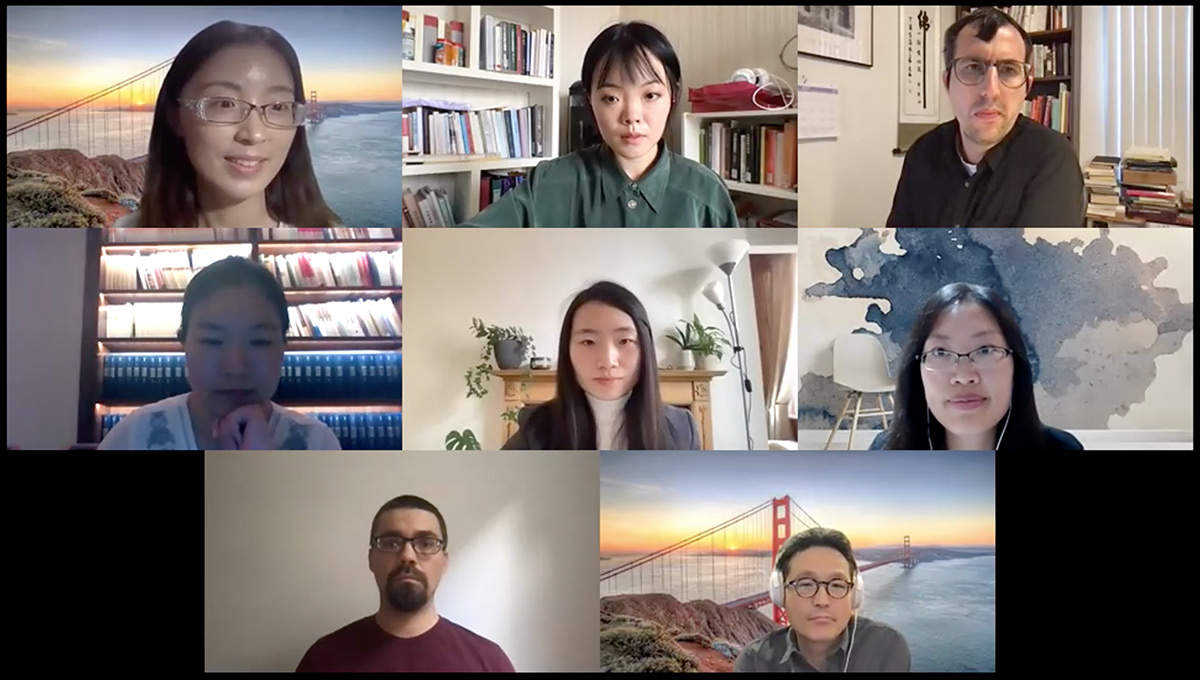
Top row: Kong Yan, Hou Xiaoming, and Tom Newhall. Mid row: Li Huawei, Ding Kehan, and Li Chunying. Bottom row: Stephan Kigensan Licha and Juhn Ahn.
Ding Kehan’s paper, “The Spatial Orientation of Chan Rituals: Bridging Buddhist Monastic Practices with Chinese State Rites in Medieval China”, investigated issues concerning sangha halls, seating arrangements, and their relation to spatial cosmology and ritual practice. Jiang Wu’s research, “Mārga and the Way: The Meaning of the Term ‘Dao-learners (Xuedaoren 學道人)’ in Huangbo Xiyun’s 黃檗希運 Chuanxin Fayao 傳心法要 [Essential Meaning of Mind Transmission] Compiled by Pei Xiu 裴休 (791-864)”, focused on the term “Dao-learners” 學道者 as attested in works by Huangbo Xiyun 黃檗希運. He also defined some characteristic features of the group known by this name. Li Chunying in “宋代儒佛之辯中的心與覺 | Mind and Awakening in the Debate between Neo Confucianism and Buddhism” examined the concepts of “mind” and “awakening” through the prism of Neo Confucianism and Buddhism, and argues that the key difference between Neo Confucian and Chan thought is through debated of these two concepts—whether there are noumenon beyond the mind or not. Stephan Kigensan Licha’s work titled, “The Zen of Mahāvairocana: Reconsidering the Taxonomy of Zen in Early Medieval Japan”, presented some features of the relation between early Zen Buddhism and the esoteric deity Mahāvairocana. Because Japanese Buddhist debate was structured by the tensions between the Esoteric and the Lotus teachings, the arrival of continental Chan texts to Japan required different adaptations and conversations than Buddhist schools in China, and Licha’s paper explores the conversations around Chan to Zen transformations. Juhn Ahn’s paper “Sudden awakening makes precepts perfect: Ven. Seongcheol’s (1912–1993) not-so-unorthodox Seon doxography” re-evaluated the controversial Orthodox Path of the Seon School from 1981 by Ven. Seongcheol, a Buddhist leader who critiqued the founder of his order, and explores how his critiques were received in a context where religious authority was lacking. Seong Uk Kim’s paper, “The Sŏn Buddhist Debate in the Late Chosŏn”, explored the subject of the late Chosŏn Sŏn debate based on discussions between Paekp’a Kŭngsŏn and Ch’oŭi Ŭisun. Sŏn was thriving in this era, and in this time of renewal, many Buddhist figures presented their own understandings of Sŏn doctrine and practice.
Day 3 (July 31)
Panel 8 discussed the topic of “Letters as Ladders? Literature and Chan Enlightenment”, chaired by Amanda Goodman (University of Toronto), with Imre Galambos who discussed papers by Li Huawei 李華偉, Marcel Werbik (Jagiellonian University), Garance Chao Zhang 張超 (EPHE), and Yanfei Zhao 趙燕飛 (SOAS University of London).

Top row: Amanda Goodman, Imre Galambos, and Li Huawei. Bottom row: Marcel Werbik, Garance Chao Zhang, and Yanfei Zhao.
In “天台止觀與語言三昧——再談中晚唐江左詩僧群體 “以文藝誘入佛智” 現象 | Tiantai Serenity-Contemplation and the Language Samadhi: Narrative of ‘Inducing Buddhist Wisdom with Literature and Art’ among Monastic Poets in Eastern China in Mid-Late Tang Dynasty”, Li Huawei contrasted different approaches to literature and discussed how the Chan school views literature in the context of “the language samadhi”. The paper also discussed the relationship between language samadhi and Tiantai meditation. Marcel Werbik in the paper, “The Spectrum of Chan Normativity within The Poems from the Cold Mountain (Hanshan shi) and Its Reception”, undertook the analysis of the reception and interpretation of non-canonical motifs in The Poems from the Cold Mountain (Hanshan shi 寒山詩) on Chinese, Japanese and Euro-American ground. Werbik also explains some non-canonical elements in Hanshan shi and how this poetry fits within the broader traditions of Buddhist poetry. Garance Chao Zhang’s paper “‘宗門隨筆’ 與日本江戶禪學對中國宋元禪文獻的再造 | ‘Shûmon zuihitsu’ (Chan Miscellanea) and Edo Zen scholarship’s reinvention of Song-Yuan Chan literature”, focused on the miscellanies or random note tradition. Firstly, the paper presented the characteristics of this genre, and then moved onto the process of its assimilation and use in the Japanese Zen school of the Edo period. Yanfei Zhao in “Thick Translation and modern representation of Chan: An analysis of three English translations of the Platform Sūtra based on Dunhuang manuscript versions” provided a theoretical basis of “thick translation” and discussed three English translations of Platform Sūtra from Dunhuang (by Chan 1963, Yampolsky 1967, and Red Pine 2006), and what model of understanding they proposed.
The topic of panel 9 was “Identity Building vs Networks Construction”, chaired by Li Chunying, with Morten Schlütter (University of Iowa) who discussed papers by Yi-hsun Huang 黃繹勳 (Shanghai University), Lu Zhang 張璐 (University of Arizona), and Michaela Mross (Stanford University); and Chen Huaiyu 陳懷宇 (Arizona State University) who discussed papers by Jiang Hainu 蒋海怒 (Zhejiang Sci-Tech University), Kong Yan 孔雁 (Institute of Religious Studies, SASS), and Zhang Fu 張芾 (Fudan University).
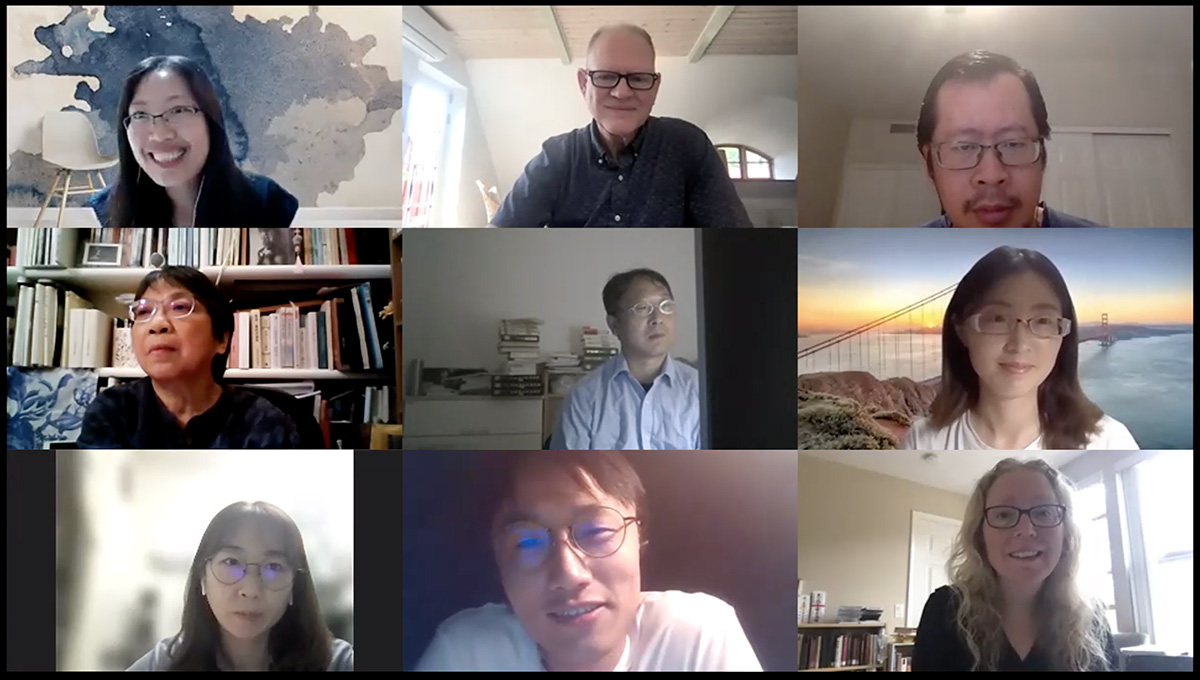
Top row: Li Chunying, Morten Schlütter, and Chen Huaiyu. Mid row: Yi-hsun Huang, Jiang Hainu, and Kong Yan. Bottom row: Lu Zhang, Zhang Fu, and Michaela Mross.
Yi-hsun Huang’s paper, “The Story of Zhenru Monastery’s Conversion to the Chan Sanfeng Lineage” was based on a few rare texts that told the story of how Zhenru Monastery 真如寺, known as a lecture monastery, turned towards Sanfeng lineage 三峰派 through influential abbots of the course of the seventeenth century. Jiang Hainu in “墓誌所見唐代世族夫人習禪風尚” [Zen Practice of Tang Dynasty Noble Women as Inscribed on Epitaphs] described the daily lives of women during the Tang Dynasty and the choices they made in the face of conflicting Buddhist and Confucian principles. Kong Yan’s research “宋代曹洞宗的社會網絡” [The Social Network of Caodong School in the Song Dynasty] introduced the subject of social connections at the Caodong School 曹洞宗 during the Song Dynasty and how this school achieved stability by relying more on local elite connections and family legacies than with emperors and their militaries. In “‘A Separate Transmission’ to ‘An All-Embracing Teaching’: A Study on the ‘Sages and Worthies as Buddhist Incarnations’ in Song Denglu Works”, Lu Zhang dealt mainly with three issues: firstly, analysis of the denglu 燈錄 genre; secondly, analysis of specific characters; and thirdly, analysis of changes that took place in the section devoted to the Incarnation, which identified a diverse yet little-noticed group of individuals as manifestations or incarnations of Buddhist deities. This identification impacted later denglu texts. Zhang Fu’s work, “Writing and Compiling in Chan Temple at the End of Yuan (1333–1368): Literary Associations and Political Personality of Zhongming Kexin 仲銘克新”, explored the links existing between literature and politics. In particular, Zhongming Kexin’s poetry note only spread to Japan and became an important part of Zen models there, but also had an impact in his local circles, using his literary connections to create and maintain his monastery’s fame. Michaela Mross in “Remembering Keizan Jōkin: Communal Memory and Founder Worship in Kōshiki” analyzed two kōshiki 講式, liturgical recitation texts, created to commemorate Keizan Jōkin 瑩山紹瑾, the differences between them, and what function they had in the context of co-creating collective memory and arguing for the high status of various affiliations.
The subject covered in panel 10 was “Make (More) Sense of Meditation”, chaired by Raji Steineck, with Eric Greene as discussant for Michel Mohr (Hawai‘i University), Tom Newhall, Morten Schlütter, Sam van Schaik (British Library), Sung Ha Yun, and Hou Xiaoming.
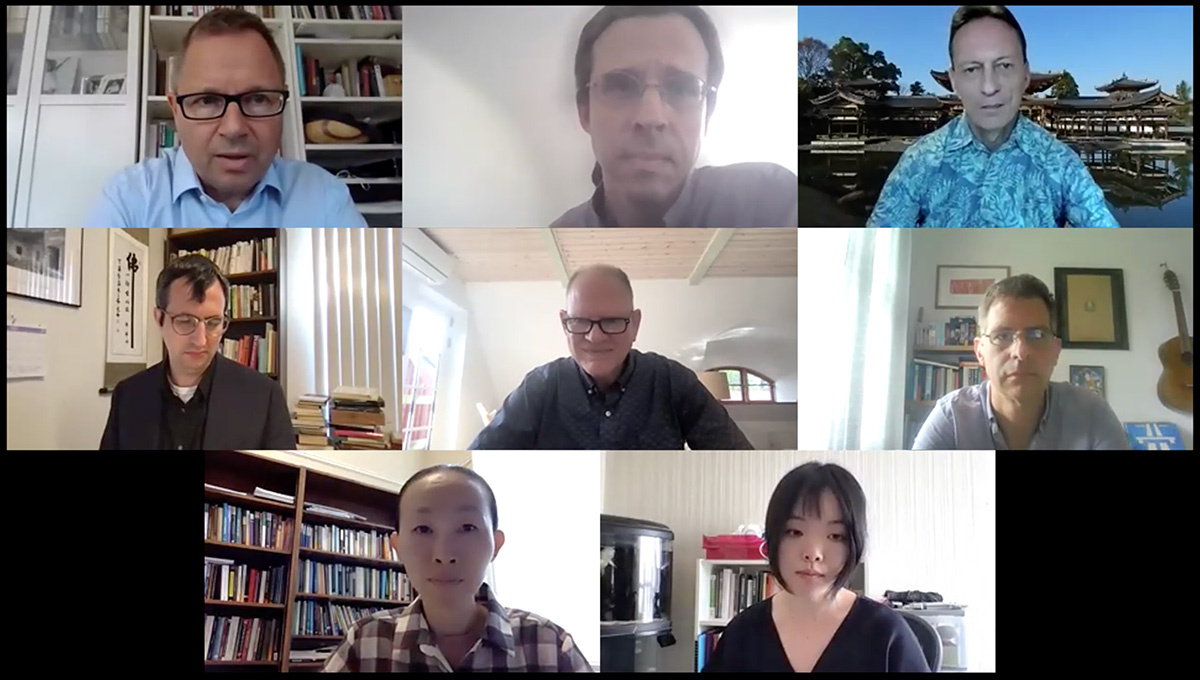
Top row: Raji Steineck, Eric Greene, and Michel Mohr. Mid row: Tom Newhall, Morten Schlütter, and Sam van Schaik. Bottom row: Sung Ha Yun and Hou Xiaoming.
Michel Mohr in “Mindfulness with Breathing Redefined: Insights from a Fifth-century Afghan Compiler” provided observations on the translation of the Meditation Sutra of Dharmatrāta (Damoduoluo chanjing 達摩多羅禪經) about the figure of the Buddhabhadra and the practice of mindfulness with breathing (annapanna nian 安那般那念). Tom Newhall’s paper titled, “The Connoisseurship of Higher Mental States: A new look at Chan kanhua and gong’an practice”, argued for the reception of kanhua 看話 as a specific model of reception resembling art appreciation. Morten Schlütter’s work, “The Silent Illumination Versus Kanhua Meditation ‘Debate’ Revisited”, introduced a new approach toward kanhua meditation by deepening the knowledge about a twelfth-century debate between Caodong and Linji leaders about silent illumination 默照 (Ch. mozhao; Jp. mukoshō) and kanhua Chan 看話禪, and also asks scholars if their readings of these ideas have been influenced by their Japanese interpretations. In “Meditation Practices in Tibetan and Chinese Chan Manuscripts from Dunhuang”, Sam van Schaik presented an analysis of Dunhuang manuscripts from Cave 17 written both in Chinese and Tibetan. Subsequently, based on an analysis of the meditation practices shown in these texts, he concluded that the overlap between Dunhuang texts and Chan texts in Chinese in Tibetan was not very extensive and there might be some other supporting sources of teaching and meditation practice. Sung Ha Yun’s work, “Sot’aesan’s Re-invention of Kanhwa Meditation in Wŏn Buddhism”, addressed two issues. Firstly, it examined Sot’aesan’s appraisal of kanhwa. Secondly, it explained Sot’aesan’s reform of kanhwa meditation within the context of the reformation of Korean Buddhism during the twentieth century. Hou Xiaoming’s paper, “Meditation Numbers: Making Sense of Meditation as a Type of Knowledge in Early Medieval China”, examined the concept of chanshu 禪數 (numerical categories of meditation teachings) and its importance in the transmission of Buddhist teachings. In intentionally organizing knowledge of Buddhist meditation, this genre was particularly efficacious in allowing individuals to conduct individual textual study of meditation.
The conference ended with words from the two co-hosts: Eric Greene and Jinhua Chen. During the conference, many valuable presentations were presented on a very wide range of topics. This international symposium contributed to the deepening of the international exchange of ideas among researchers from around the world and was an excellent opportunity that contributed to a step forward in the development of this academic discipline.
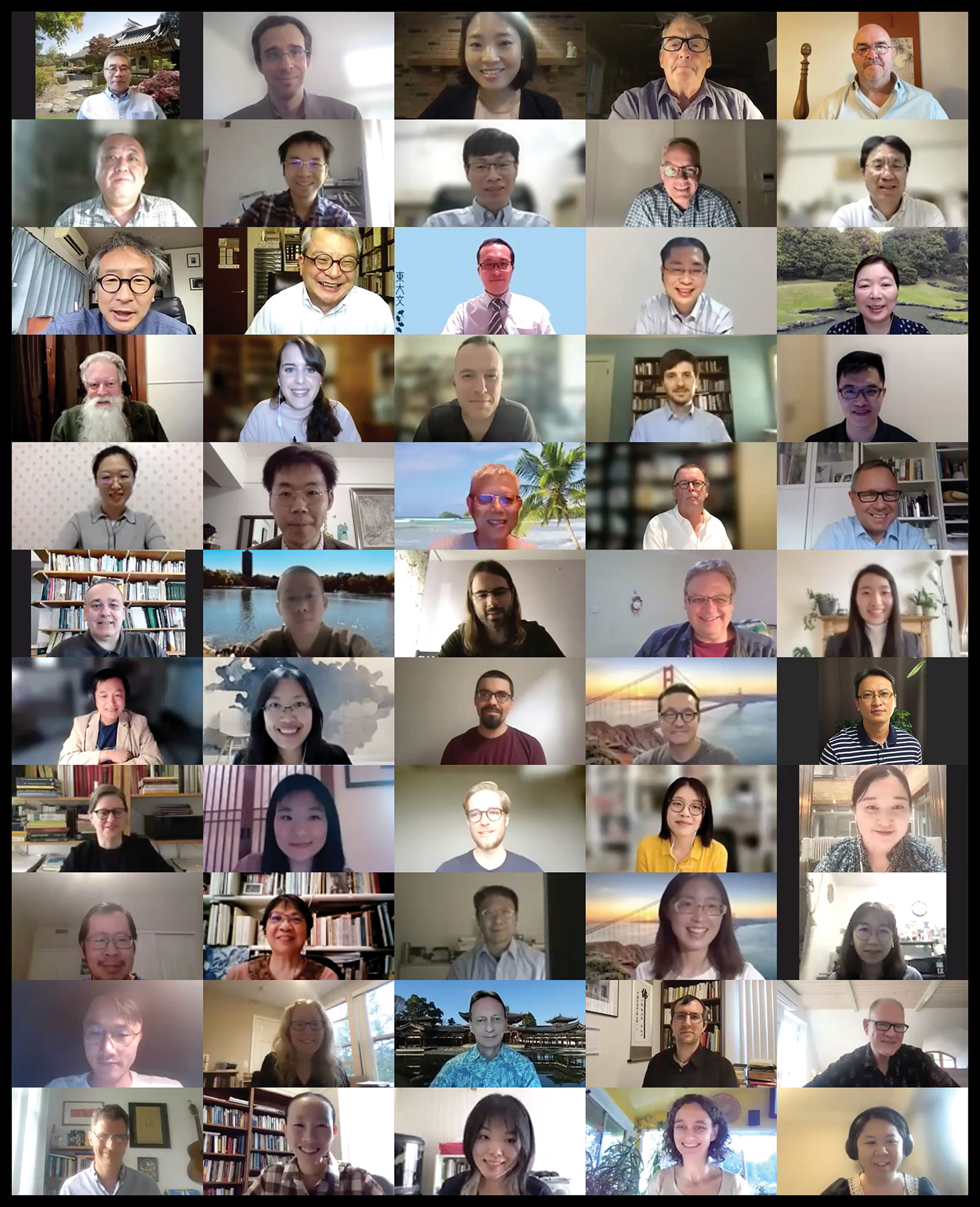
How Zen Became Chan: Pre-modern and Modern Representations of a Transnational East Asian Buddhist Tradition conference group photo.







